


The Mughal Emperor Jehangir said it all when he visited Kashmir in the 17th century. You’ve been places and you’ve been places, but if you have not visited this Paradise on Earth, you’ve missed out on an experience of a lifetime. The name Kashmir, in Sanskrit, implies land desiccated from water and is derived from the two words, "ka" (water) and "shimeera" (to desiccate). According to Hindu mythology, Sage Kashyap drained the erstwhile lake to produce the land of Kashmir. Modern day Jammu and Kashmir (J & K) is the northernmost state of India, lying mostly in the Himalayas. The state is bordered on the south by Himachal Pradesh, on the west by Pakistan, and on the north and east by China.
(J & K) consists of three divisions: Jammu, the Kashmir Valley, and Ladakh. Srinagar is its summer capital, and Jammu, its winter capital. (J & K) is India’s only Muslim majority state. Minority religions in the state include Hinduism, Buddhism, and Sikhism. The languages spoken here are Kashmiri and Urdu, with most people also speaking Hindi and English.
Kashmir is the only Indian state to witness all four seasons (spring, summer, autumn, and winter) and has something on offer for every type of traveller. While its quiet, almost virginal beauty makes it the ideal honeymoon getaway, it is also great for a family vacation, offering activities like shikara rides, horse riding, cable car rides, and much more. Adventure-seekers can trek the lovely mountainous terrain of Ladakh, and nature lovers will be smitten by the verdant greenery of the valley in summer and its snow-topped mountains in winter. For religious travellers, Kashmir offers the famous Amarnath Cave, a 5,000-year old shrine dedicated to Lord Shiva, where an ice stalagmite is formed every year in the shape of a Shivling.
Once you come here, you are sure to fall in love with its beautiful gardens, vast lakes, pristine streams, alpine forests, stunning mountains, and, most of all, its friendly people. Kashmiris are very warm and welcoming people.
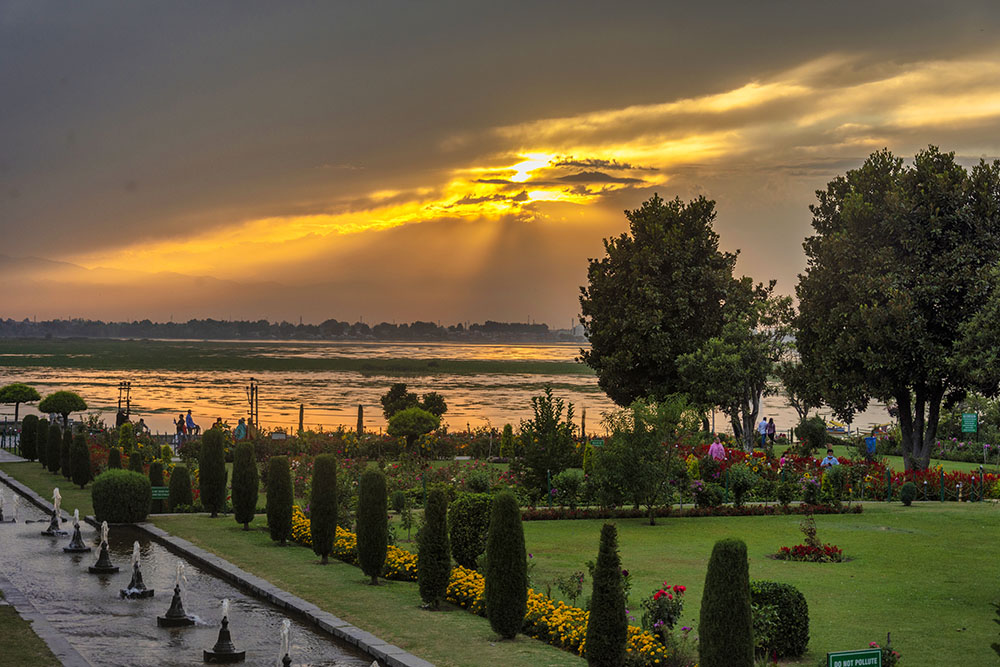
Also called the "Garden of Pleasure", Nishat Garden lies on the left bank of the Dal Lake, with the Zabarwan Mountains as its backdrop. The Mughal garden commands a magnificent view of the lake beneath the snow-capped Pir Panjal mountain range.
Asif Khan, the elder brother of Nur Jehan, designed and built Nishat Bagh in 1633. The garden is a broad cascade of terraces lined with avenues of chinar and cypress trees, starting from the lakeshore and reaching up to an artificial façade at the hill end. Nishat has twelve terraces representing the twelve signs of the zodiac.
The Shalimar Garden, one of the Mughal Gardens of Kashmir, was built by Emperor Jehangir for his wife, Nur Jehan, in 1616. Located on the right bank of Dal Lake, Shalimar Bagh is linked through a channel to the northeast of the lake.
Shalimar Garden has four terraces and a number of fountains, shaded trees, and innumerable varieties of flowers. The best views of the garden’s beauty are afforded during autumn and spring, when leaves change colors and flowers blossom, respectively. One can also enjoy a sound-and-light show (son et lumeiere) in the evening, organized daily during the tourist season, May to October.

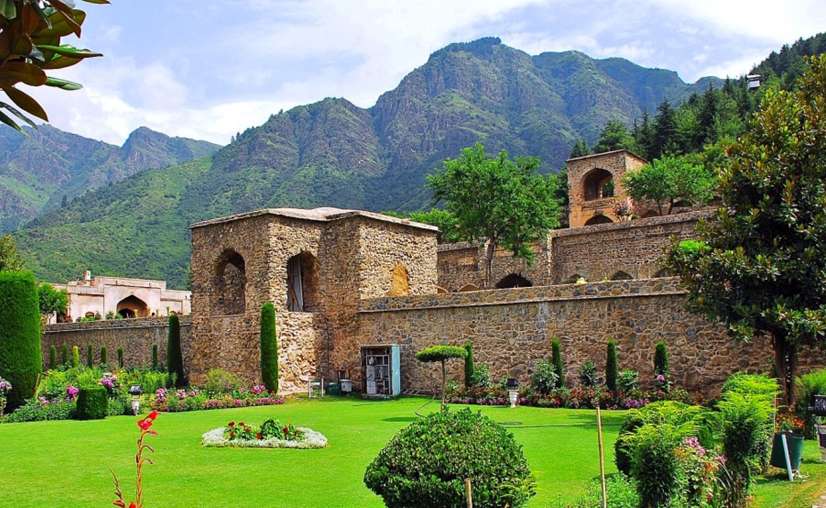
Situated near the Chashma Shahi Mughal garden, Pari Mahal has beautiful terraced gardens and the ruins of a five-storied Mughal building that is illuminated in the evening. It offers a fantastic view of the Dal Lake and the city of Srinagar and is the ideal place for some soul searching.
Mahal is valued more as a historical monument than a park or a garden. The Mahal was initially a Buddhist monastery, which was later converted into an observatory and a school of astrology by Dara Shikoh, the eldest son of Emperor Shah Jahan. He dedicated the place to his Sufi teacher, Mulla Shah..
The smallest of Srinagar’s Mughal gardens, the Chashma Shahi, or Royal Spring, was laid out by Emperor Shah Jahan in 1632. "Chashma" in Urdu means "waterfall". The garden was so named because of a mountain spring/waterfall that feeds it. The famous freshwater spring inside the garden is believed to have medicinal values. As legend goes, when Mumtaz Mahal (Shah Jahan’s wife) fell ill and could not be cured even by the world’s best doctors, somebody suggested she be taken to some health resort.
Shah Jahan preferred to stay at Pari Mahal in Kashmir along with his queen. She enjoyed the fresh air and flora and drank the sweet water of Chashma Shahi, resulting in a dramatic improvement in her health. Since then, the water here is thought to have medicinal properties. The garden abounds in fruits, flowers, and chinar trees.
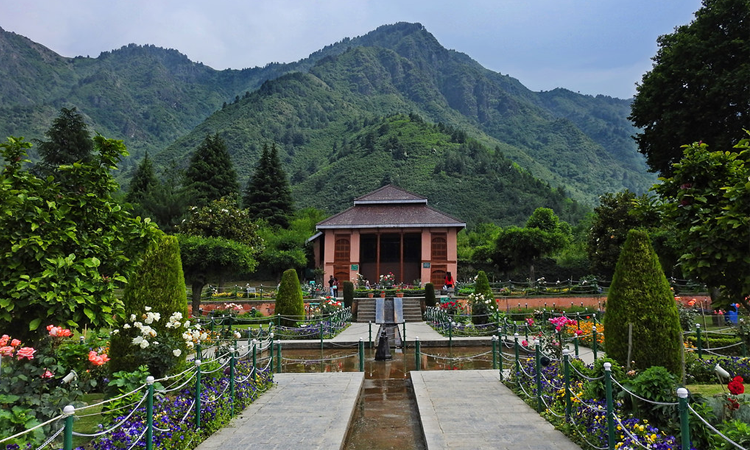
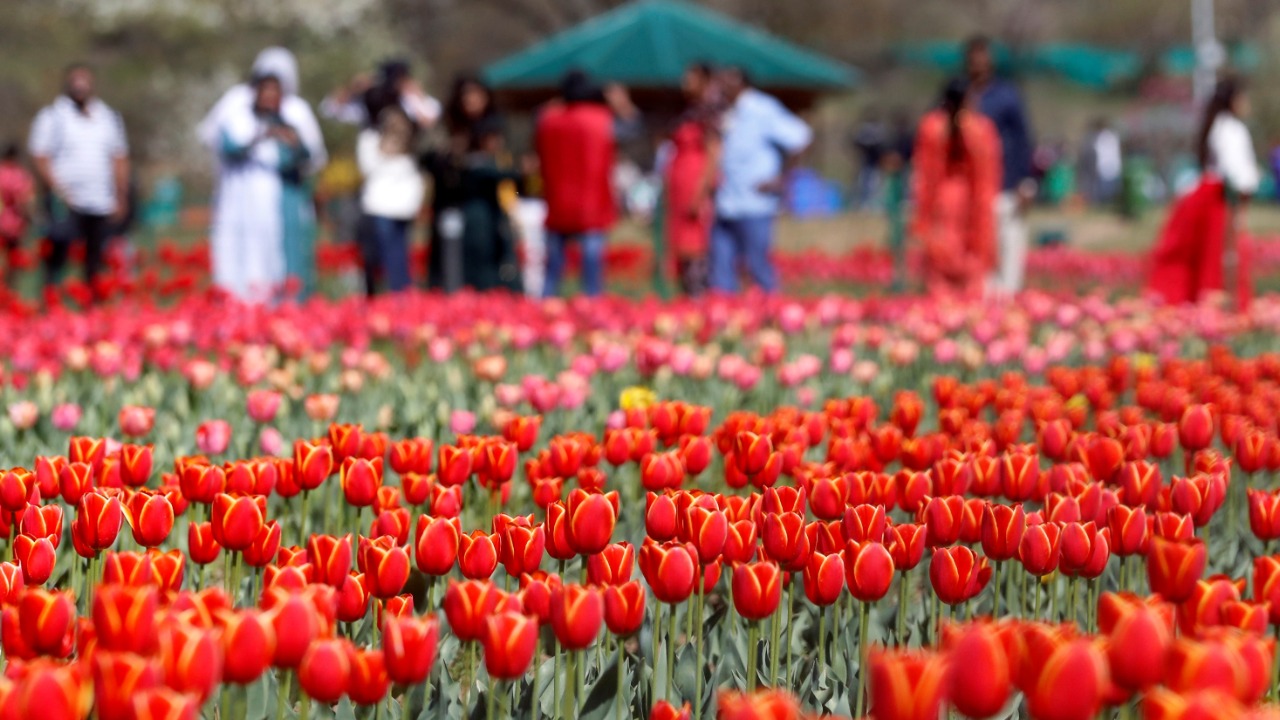
The Tulip Garden in Chashma Shahi, Srinagar, is spread over an area of about 30 hectares and is situated at the foothills of the Zabarwan Hills with an overview of the Dal Lake. This garden was created in the years 2006-07 with the aim of boosting floriculture and advancing tourism in the Kashmir Valley.
Lakhs of tulips in about 68 varieties bloom here during November and December, making the entire garden look like a bright, colourful carpet of flowers. The best time to visit the tulip garden is between March-end and early April.
The white-domed shrine contains a relic believed by many Muslims of Kashmir to be a hair of the Islamic Prophet Muhammad. The name of the shrine comes from the Arabic word "hazrat", meaning holy or majestic, and the Kashmiri word ‘bal’, (a corrupted form of the Sanskrit "vala", which means an enclosure), meaning place.
The shrine is situated on the left bank of the Dal Lake and is considered to be Kashmir's holiest Muslim shrine. Hazratbal is known by many names, including Assar-e-Sharief, Madinat-us-Sani, Dargah Sharief, and Dargah.
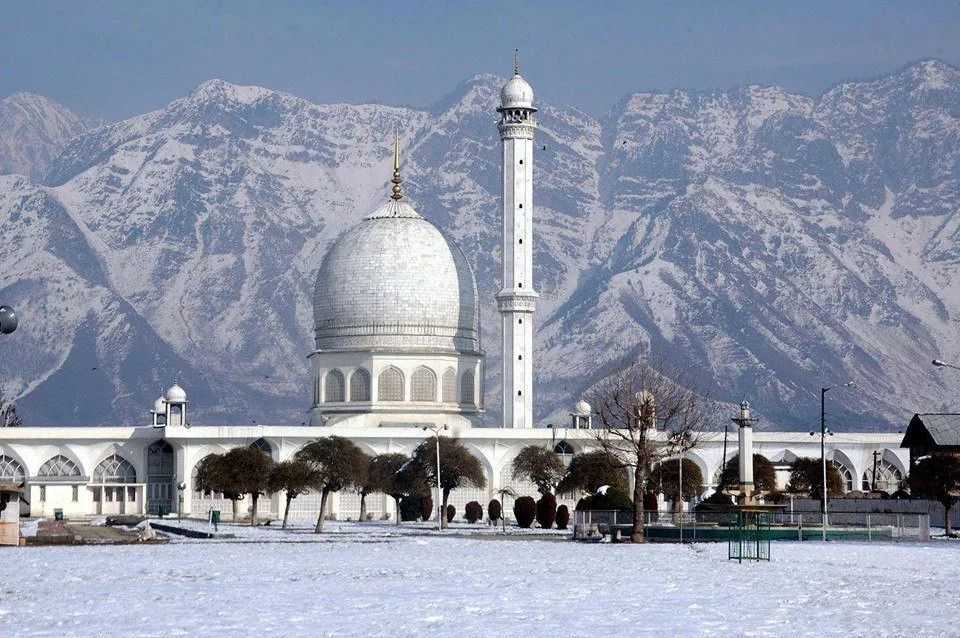

Located about 18 km from Srinagar, Harwan is a huge garden lined with flowerbeds and massive chinar trees. A canal passes through the garden, which is dotted with bright, colourful flowers. The fresh air and big, green-carpeted lawns make it an ideal spot for picnics and excursions.
The garden serves as a gateway to the famous wildlife sanctuary of Dachigam and Mahadev Mountain. Behind the garden, there is the small but beautiful Harwan lake, which feeds the garden and provides an astounding view of the majestic mountains.
Shankaracharya Temple is an ancient temple located on Gopadari Hill dedicated to Lord Shiva. A climb to the hill, located in southeast Srinagar, will take about 40 minutes. This is said to be the oldest shrine in the Kashmir valley. It stands on a solid rock and consists of an octagonal basement of 13 layers.
Be it the chanting of shlokas or the offering of prayers to the presiding deity, Shankaracharya represents the traditional beliefs and customs of Hinduism. The temple offers a panoramic view of the valley. Early April, when the snow lies thick on the mountains, or after rain on a summer day, offer the best views from the hill.

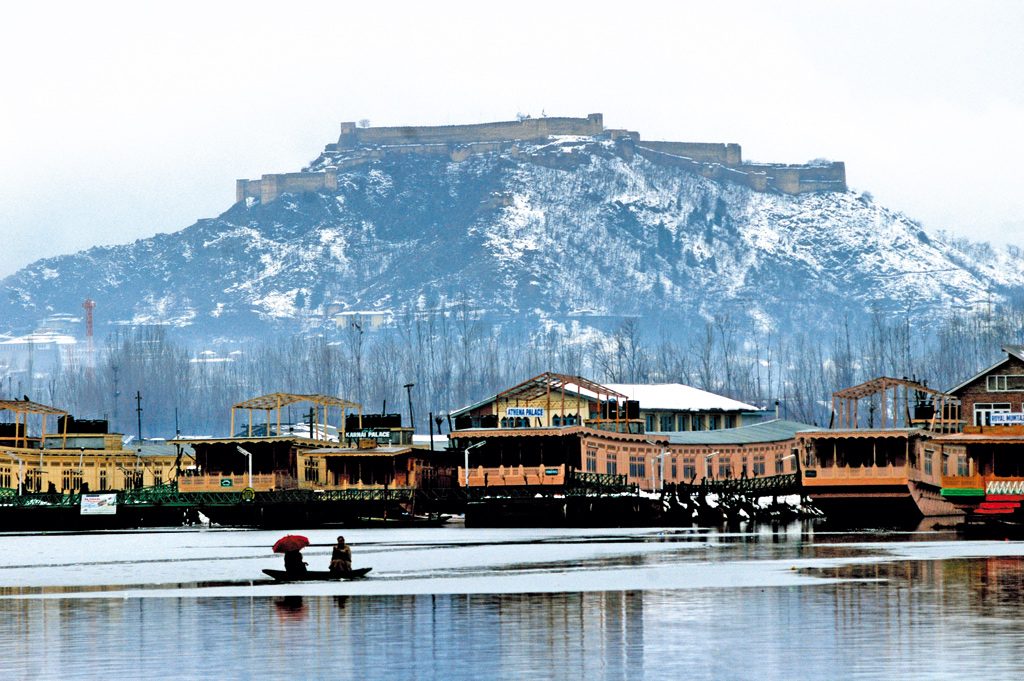
Hari Parbat, a hill overlooking Srinagar, is the site of a Durrani fort, built in 1808. The fort was constructed by Ata Muhammad, an Afghan governor. The wall around the hill was built by the Mughal Emperor Akbar. Hari Parbat is sacred to Hindus, Muslims, and Sikhs as it has the famous Shakti Temple on the western slope and the Muslim shrines of Khwaja Makhdoom Sahib and Akhund Mullah Shah on the southern slope.
On the southern side of the outer wall, there is a gurudwara, which commemorates the visit of Guru Hargobind to Kashmir.
The temple is dedicated to Goddess Kheer Bhawani (originally just Bhawani) and is constructed over a sacred spring. The colour of the spring’s water changes occasionally. When black or dark, it’s believed to be an indication of inauspicious times for Kashmir. The famous Kheer Bhawani temple is located in the village of Tulla Mulla, about 22 km from Srinagar.
The worship of Kheer Bhawani is universal among the Hindus of Kashmir. The term "kheer" refers to the rice pudding that is offered in the spring to appease the Goddess, which became part of the name of the temple. As is the custom with Hindu deities, Goddess Kheer Bawani has many names: Maharagya Devi, Ragnya Devi, Rajni, Ragnya Bhagwati, and so on.


Playing golf at Royal Spring Golf Course is a transcendental experience for golfers and nature lovers alike. This scenic golf course in natural environs, against the dramatic backdrop of the Zabarwan Mountains, overlooks the Chashma Shahi garden, and the course itself contains four of the Royal Springs. The entire golf course was carved out of a forest.
As you enter the course, an array of tall trees and the clubhouse greet you, leading you to the magnificent golf course, with breathtakingly beautiful surroundings. The course is a professional 18-hole par 72 track that covers an area of 7,089 yards. Royal Spring Golf Course, which has hosted many international golfing events, is perfect for beginners as well as professionals.
The smaller Nigeen Lake, or Nagin Lake, flows from Dal Lake. Nagin Lake, which is usually thought of as a separate lake, is divided from Dal Lake only by a causeway. The causeway is mostly suitable for walkers and bicycles only, so it makes for a pleasant way of seeing the lake without having to worry about traffic or Shikaras. The waters are edged by trees of willow and poplar whose reflection is mirrored in the lake.
"Bathing boats" here, as well as on the Dal, hire out water-skis and motor launches. The waters of the lake are pleasantly cool from mid-May to mid-September. Shikaras can be hired from any of the steps called "ghats" (jetties) leading to the lake, and are a refreshingly novel way of seeing Srinagar by day and at twilight.

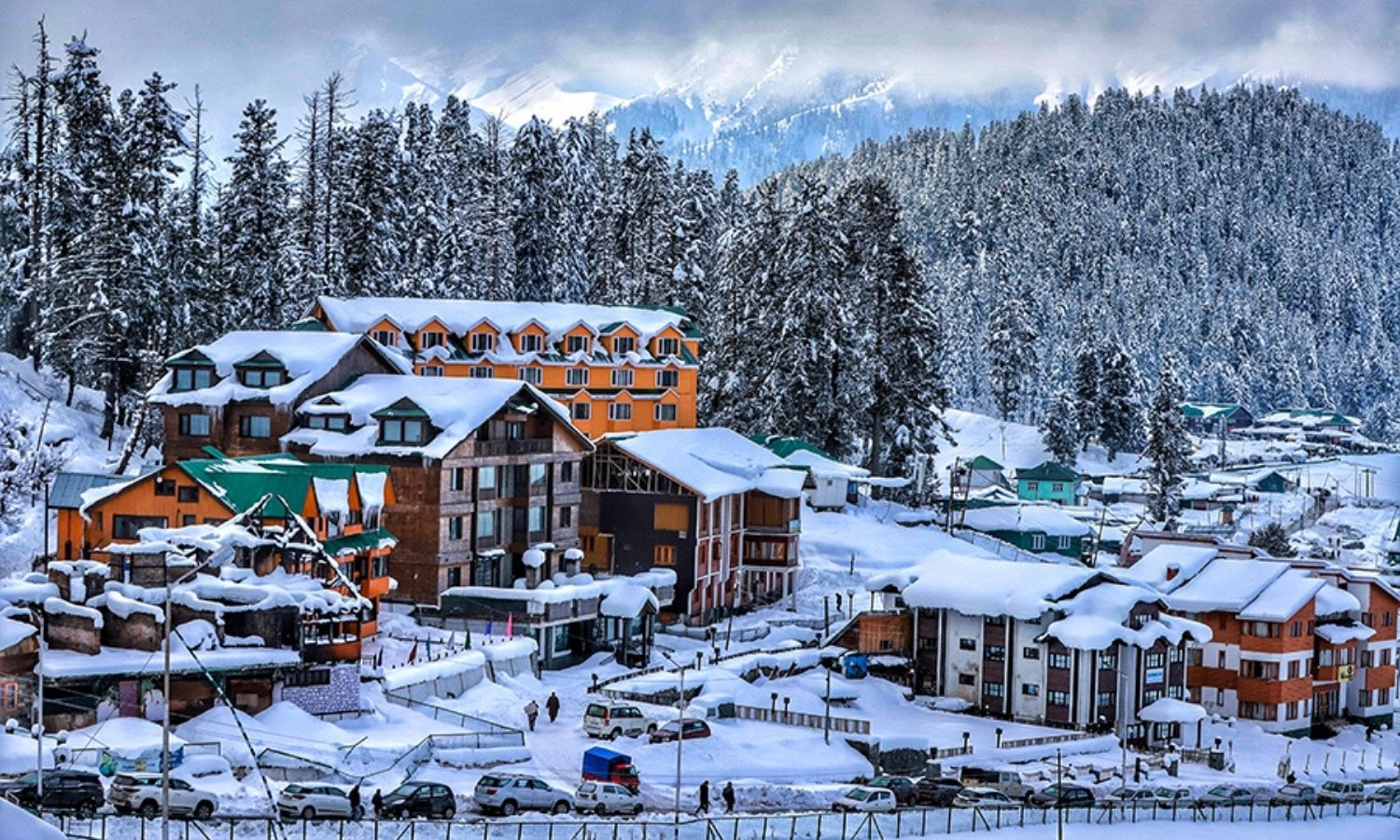
Gulmarg’s legendary beauty, prime location, and proximity to Srinagar make it one of the premier hill resorts in the country. While Gulmarg is an all-weather retreat with refreshing summer meadows and pastoral scenes to keep the camera busy, the main reason to come here, at least in winter, is the long-run skiing and snowboarding. Gulmarg is one of the newest and most popular ski destinations.
It is also famous for the world’s highest gondola (cable car) ski lift, which will take you from a height of about 8,825 feet to 13,780 feet amid verdant, snow-capped steep hills. Also known as the "Meadow of Flowers", Gulmarg is located 53 km from Srinagar at an altitude of 2,700 metres above sea level. It is surrounded by tall conifers and snow-capped mountains.
Sonamarg, also called the "Meadow of Gold", is 87 km from Srinagar and lies at an altitude of 3,000 metres (9,842 feet) above sea level. Soak in the sights and sounds of Kashmiri village life on your drive there. Sonamarg has as its backdrop snow-capped mountains against a cerulean sky. The Sindh River meanders along here and abounds with trout and mahseer; snow trout can be caught in the main river.
One can also hire ponies for a trip to the Thajiwas glacier, a major attraction during the summer months. From Sonamarg, trekking routes lead to the Himalayan lakes of Vishansar (4,084 m), Krishnasar (3,810 m) and Gangabal (3,658 m). Other lakes in the region are Gadsar, stocked with snow trout, and Satsar, glacier-fed and surrounded by banks of alpine flowers.

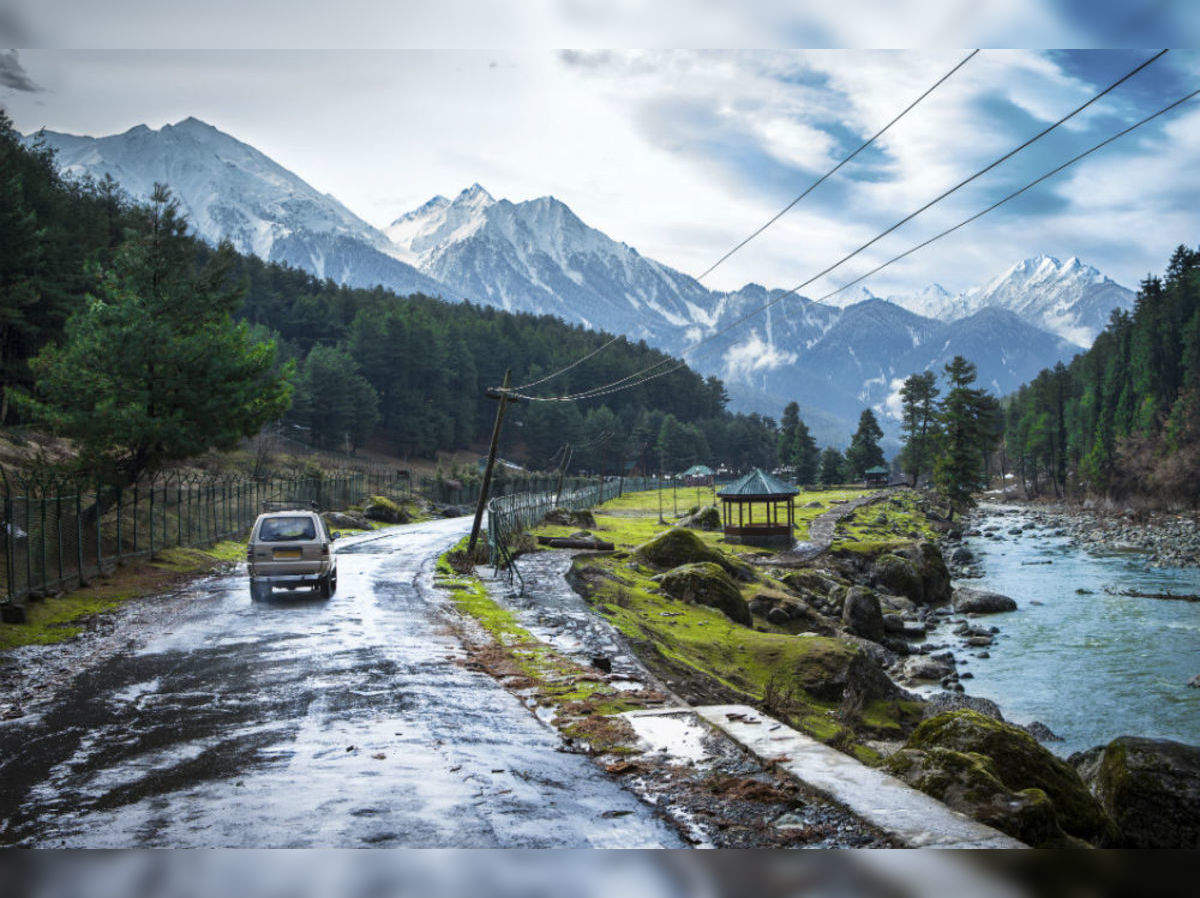
The picturesque beauty of Pahalgam, or the "Valley of Shepherds", with its streams, valleys, and woods will make you feel like you are in paradise. Connect with nature in the lap of the mountains, relax in one of its hotels, or trek on one of the many mountains here. One can trek to Lidderwat, Kolohoi Glacier, or to Sonamarg from Pahalgam. The resort is surrounded by many places of interest, like Baisaran Hajan or Betab Ghat, enroute to Chandanwari.
Pahalgam is 95 kilometers from Srinagar and has an average elevation of 2,740 metres (8,980 feet).Skiing is a major tourist attraction during the winter months (from December to late February or early March). During spring, the abundance of wild flowers is breathtaking. Pahalgam is also the entry point for the famous Amarnath Cave, a holy shrine for the Hindus.
Yusmarg is a small meadow set in the heart of the mountains to the south-west of Srinagar. A two-hour drive from Srinagar (47 km) will take you to acres upon acres of grassy meadows, ringed by forests of pine, and towering beyond them are majestic snow-clad mountains.
It is an ideal picnic spot, and the Nilnag Lake can be visited from here.


Dachigam, which means "ten villages", could have been named in the memory of the ten villages that were relocated for its formation. The park has been a protected area since 1910 and is famous for its coniferous forests and for the "hangul," or Kashmiri stag. The wild trees of the park take in wild cherry, plum, peach, apple, apricot, walnut, oak, willow, poplar, chinar, pine, and elm. Wildlife lovers can see animals like musk deer, leopard, Himalayan grey langur, Himalayan black bear, jackal, fox, jungle cat, and more.
The park is an ornithologist’s delight and one can spot cinnamon sparrow, black bulbul, Himalayan monal, golden oriole, minivet, woodpecker, babbler, etc here. The wildlife sanctuary, which is 22 km from Srinagar, covers an area of 141 sq km.
Manasbal Lake is about 32 km from Srinagar. Manasbal is said to be the deepest lake in the Kashmir Valley, with a depth of 13 metres (43 feet).
Manasbal is famous for its aquatic birds and the lotuses that bloom here in the months of July and August. You can enjoy a shikara ride and take in the serene beauty of the lake.


Kokernag gets its name from two words—"koker," meaning "fowl," and "nag," meaning "serpent." A spring gushes out here at the base of a densely forested hill, where it divides into channels resembling a hen's claw, hence the name.Kokernag has been mentioned in the "Ain-e-Akbari", which says the water of the spring has medicinal and digestive properties.
The Kokernag spring bubbles up at seven places at the foot of a forested mountain. Situated in the heart of the Bringhi valley, 70 km from Srinagar, Kokernag, which stands at 2,020 metres (6,627 feet), is set amidst sprawling gardens fragrant with thousands of blooming flowers. The place is famous for its gardens, freshwater springs, and trout.
The towns and villages situated around Kokernag are Wangam, Hangalgund, Sangam, Zalergam, Duksum, etc.